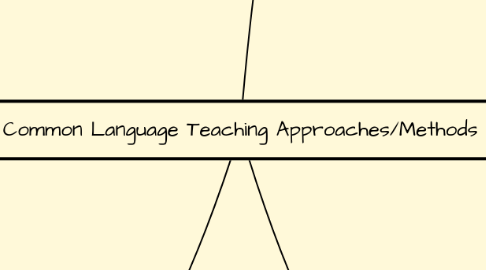Common Language Teaching Approaches/Methods
por Rosa Argueta


1. Direct Method
1.1. The Direct Method is named "direct" because meaning should be connected directly with the target language without translation into the native language.
1.2. Objectives
1.2.1. Research and prepare experiment
1.3. The basic premise of the Direct Method is that students will learn to communicate in the target language.
1.4. There is to be a direct connection between concepts and the language to be learned.
1.5. Typical Techniques
1.6. Question and Answer Exercise
1.6.1. Reading Aloud
1.7. Conversation Practice
1.7.1. Student Self-Correction
1.8. Fill-in-the-blank Exercise
1.8.1. Paragraph Writing
1.8.1.1. Dictation
2. Audiolingual Method
2.1. It's a method of foreign language teaching which emphasizes the teaching of listening and speaking before reading and writing. It uses dialogues as the main form of language presentation and drills as the main training techniques.
2.2. Objectives
2.3. To create communicative competence in learners.
2.4. The most effective way to do this was for students to "over-learn" the language being studied through extensive repetition and a variety of elaborate drills.
2.5. Typical Techniques
2.6. Dialog Memorization
2.6.1. Backward Build-up (Expansion Drill)
2.7. Repetition Drill
2.7.1. Chain Drill
2.7.1.1. Single Slot Substitution Drill
2.8. Multiple-slot Substitution Drill
2.8.1. Transformation Drill
2.9. Question-and-answer Drill
2.9.1. Use of Minimal Pairs
2.10. Complete the Dialog
2.10.1. Grammar Games
3. Grammar Translation Method
3.1. It is a traditional technique of foreign-language teaching based on explicit instruction in the grammatical analysis of the target language and translation of sentences from the native language into the target language.
3.2. Objectives
3.3. To give learners access to English literature.
3.4. To develop their minds "mentally" through foreign language learning.
3.5. Typical Techniques
3.6. Translation of a Literary Passage
3.6.1. Reading Comprehension Questions
3.7. Antonyms/Synonyms
3.7.1. Cognates
3.8. Deductive Application of Rule
3.8.1. Fill-in-the-blanks
3.9. Memorization
3.9.1. Use Words in Sentences
3.9.1.1. Composition
